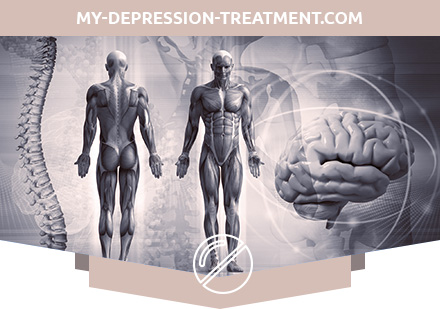What is Somatized Disorder?
Somatized disorder (Briquet’s syndrome) is a mental disorder.The main symptom is the presence of multiple, recurring and often mutating somatic symptoms, usually with a successive survey it is possible to identify at least 13 complaints, with a constant change in the leading somatic syndrome. Symptoms usually do not have a basis in the form of structural lesions of organs and tissues and are observed for a number of years preceding the patient’s visit to a psychiatrist. Most patients traveled a long and difficult path, including primary and special medical services, during which negative results of examinations were obtained and useless operations could be performed. Symptoms can relate to any part of the body or system, but the most common gastrointestinal sensations (pain, belching, regurgitation, vomiting, nausea, etc.), as well as abnormal skin sensations (itching, burning, tingling, numbness, soreness) etc.). Sexual and menstrual complaints are frequent. Often there is a distinct depression and anxiety. This may justify a specific treatment.
Pathogenesis during Somatized Disorder
Somatized disorder usually begins at the age of about 20 years, and by the age of 30, patients are already confident that they have a serious illness and have extensive experience with doctors, healers, and healers. The disease is usually chronic in nature, with a wave-like course. It is accompanied by a variety of emotional disorders (anxious, depressive spectrum) and is often combined with a prolonged violation of social, interpersonal and family behavior. The disorder is much more common in women than in men, and often begins at a young age. Often, addiction or abuse of drugs (usually sedative or analgesic) is detected as a result of frequent medical courses.
Symptoms of a Somatic Disorder
Symptoms resembling somatic disease, however, constant complaints despite excessive detail, are vague, inaccurate and inconsistent in time. As a rule, patients turn to therapists first of all, then, being dissatisfied with the lack of treatment results, to narrow specialists, they use expensive, sometimes invasive, diagnostic methods, are often hospitalized in somatic hospitals and undergo unsuccessful surgical interventions .. The somatic is framed by the emotional instability, anxiety, low mood, not reaching the level of depression, decline in physical and mental strength, in addition, irritability, feelings are often present about inner tension and dissatisfaction. Exacerbation of the disease is provoked not by physical exertion or by changes in weather conditions, but by emotionally significant stressful situations. Patients can neither be reassured nor convinced that the painful manifestations are associated with mental factors.
Diagnosis of Somatized Disorder
A reliable diagnosis requires all of the following signs:
- the presence of at least 2 years of multiple and variable somatic symptoms for which no adequate somatic explanation was found;
- constant disbelief of various doctors who tried to dissuade the patient in the existence of an organic cause of their symptoms, and refusal to follow their advice;
- some part of the violation of social and family functioning can be attributed to the nature of the symptoms and the behavior caused by them.
Differential diagnosis. Differentiation with the following disorders is important:
- Somatic disorders. The most difficult thing is to differentiate somatoform disorder from some somatic diseases, such as multiple sclerosis, systemic lupus erythematosus, etc., starting with non-specific, transient manifestations. Here, the doctor must select from the set of clinical symptoms those that are characteristic of the listed diseases. So, multiple sclerosis often begins with transient motor, sensory (paresthesia) and visual disturbances. Hyperparathyroidism can occur with osteoporosis (loosening and tooth loss), and systemic lupus erythematosus often begins with polyarthritis, to which polyserositis gradually attaches.
However, one should take into account the likelihood of an independent somatic disorder in such patients, which is not lower than in ordinary people at the same age. Particular attention in the case of a change in emphasis in patients’ complaints or their stability, when further examinations are needed. - Affective (depressive) and anxiety disorders. Depression and anxiety of varying degrees often accompany somatized disorders, but they should not be described separately unless they are clear and stable enough to justify their own diagnosis. The appearance of multiple somatic symptoms after the age of 40 may indicate a manifestation of primary depressive disorder.
- Hypochondria disorder. In somatized disorder, the emphasis is on the symptoms themselves and their individual manifestation, while in hypochondriacal disorder, attention is focused more on the presence of an alleged progressive and serious painful process, as well as its disabling consequences. In hypochondriacal disorder, the patient more often asks for an examination in order to confirm the nature of the alleged disease, while a patient with a somatized disorder asks for treatment in order to remove the existing symptoms. With somatized disorder, there is usually an excessive use of drugs, while patients with hypochondriacal disorder are afraid of drugs, their side effects and seek support and reassurance through frequent visits to various doctors.
- Delusional disorders (such as schizophrenia with somatic delirium and depressive disorders with hypochondriacal ideas). The bizarre features of ideas, combined with a smaller number and a more constant nature of somatic symptoms, are most typical of delusional disorders.
A short-term (less than 2 years) and less pronounced in intensity combination of symptoms is better classified as an undifferentiated somatoform disorder.
Treating Somatized Disorder
The main role in the treatment belongs to psychotherapy. Pharmacotherapy aims to create the possibilities of psychotherapy and is carried out to correct the associated symptoms. The choice of drugs in each case is determined by the characteristics of the symptoms and associated manifestations. The following groups of drugs are used for pharmacotherapy: first-choice drugs are antidepressants (tricyclic and SSRI groups); second-choice drugs are beta-blockers and normotimics; at the initial stages of treatment, a combination of an antidepressant with benzodiazepine is possible; antipsychotics with a sedative effect are also used as reserve drugs with severe anxiety that cannot be stopped with benzodiazepines. In addition, the therapy of somatoform disorders must be supplemented with vasoactive, nootropic drugs and vegetative stabilizers.

